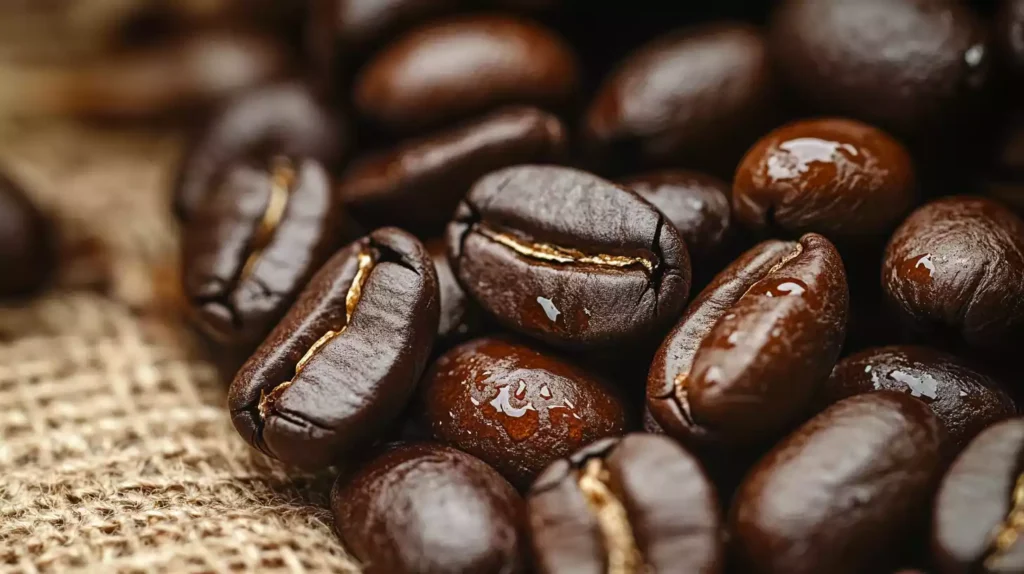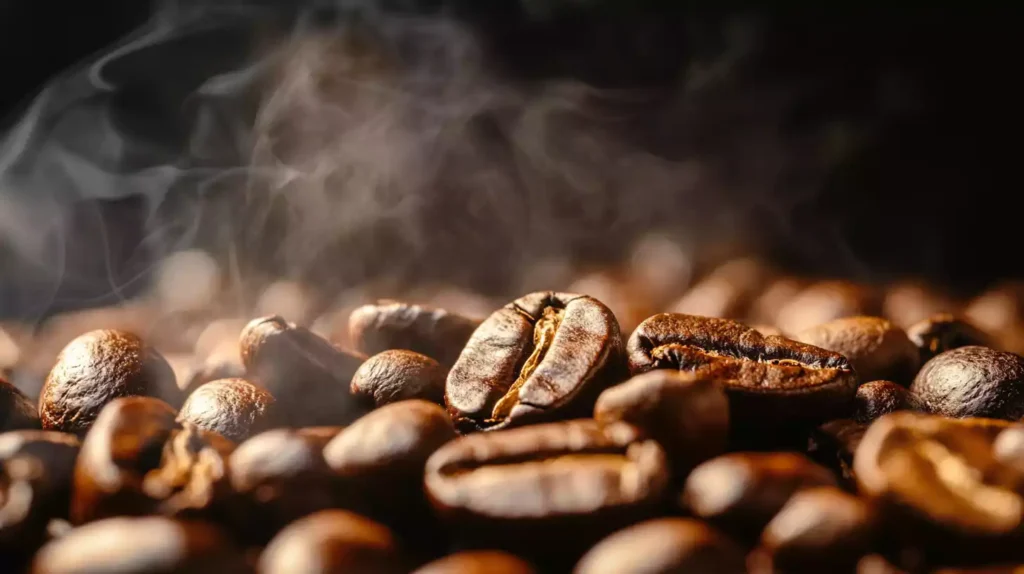I’ve often wondered about those shiny, oily coffee beans I sometimes see at the store. If you’re like me, you might have assumed all coffee beans should look that way. But there’s actually a fascinating explanation behind why some beans appear oily while others don’t.
It’s all tied to the roasting process and several other factors that influence the bean’s appearance and flavor. Understanding these elements can help you make better choices when selecting your coffee and even improve your brewing techniques.
Let’s look at what’s really going on with those glossy beans.
Quick Summary
- Darker roasts allow more oils to seep out of the beans, resulting in a shiny surface.
- The roasting process causes internal oils to develop and migrate to the bean’s surface.
- Freshly roasted beans may become oily over time as oils continue to emerge.
- Different coffee bean varieties have varying oil content, with Arabica beans typically being oilier.
- Storage conditions, such as heat and humidity, can accelerate oil seepage from coffee beans.

The Roasting Process Affects Oiliness
Many coffee enthusiasts don’t realize that the roasting process is the key to understanding why some coffee beans appear oily. Let me break it down for you.
When I roast coffee beans, I’m basically cooking them. As the beans heat up, they undergo some pretty dramatic changes. It’s vital to monitor the temperature throughout the process to achieve the desired roast level and avoid burning the beans.
First off, the beans start to turn from green to various shades of brown. That’s the Maillard reaction at work, folks. It’s the same thing that makes your toast golden brown. But here’s where it gets interesting: oils start developing inside the beans as the roast progresses.
Now, if I’m going for a light or medium roast, those oils mostly stay put. But if I crank up the heat and go for a dark roast, those oils start to seep out. That’s why you’ll often see dark roast beans with a shiny, oily surface.
It’s not some fancy coating – it’s just the bean’s natural oils coming to the surface.
Chemical Changes During Roasting
During the roasting process, coffee beans undergo a series of complex chemical changes that transform their flavor profile and appearance. Let’s look into what’s really happening inside those little beans as they heat up…
You’ve got to understand that roasting isn’t just about making the beans brown. It’s a science experiment in your roaster! Here’s what’s going down:
- Maillard Reaction: This fancy-sounding process creates those delicious roasty flavors we love.
- Caramelization: Sugars break down, giving us those sweet, caramel-like notes.
- Oil Migration: The beans’ natural oils start moving to the surface, sometimes making them look shiny.
Understanding coffee roast levels is vital, as they substantially influence the final flavor profile. The transformation from green, grassy notes to rich, full-bodied experiences is a delicate balance of heat, timing, and potential.
Now, don’t get too caught up in the tech talk. The key thing to remember is that these changes are what make your coffee taste like, well, coffee.
As the beans heat up, they’re losing moisture and developing flavors. It’s like they’re going through coffee puberty – awkward at first, but they come out the other side with a whole new personality.
So next time you’re sipping your brew, give a little nod to chemistry for making it all possible.
Factors Affecting Bean Oiliness
Ever wonder why some coffee beans look like they’ve just had an oil bath? Well, it’s not because they’re trying to get a tan. Several factors contribute to this oily appearance:
- It’s all about the roast. Darker roasts tend to be oilier because they’ve been cooked longer, allowing more oils to rise to the surface. If you’re seeing shiny beans, chances are they’ve had a good, long roast. The roasting level affects not only the oiliness but also the flavor and aroma of the coffee, with dark roasts typically offering intense and bold flavors.
- Consider the bean’s age. Freshly roasted beans might not look oily right away, but give them a few days, and they’ll start to shine. It’s like they’re aging into their oily glory.
- The type of coffee bean matters too. Some varieties are naturally oilier than others. Robusta beans, for instance, tend to be less oily than their Arabica cousins.
- Storage conditions play a role as well. Heat and humidity can make oils seep out faster. So, if you’re keeping your beans in a sauna, don’t be surprised if they look like they’ve been dipped in olive oil.
Impact on Flavor Profile

Flavor enthusiasts, take note: the oiliness of coffee beans substantially impacts their taste profile. Oily beans often deliver a bolder, more intense flavor. That’s because those oils carry concentrated taste compounds. You’ll likely notice:
- A fuller body
- Heightened aromatic notes
- A slightly bitter aftertaste
But don’t assume oily always means better. Sometimes, excessive oil can mask subtle flavors you’d otherwise enjoy. It’s like drowning your taste buds in flavor overload – not always a good thing.
Here’s the kicker: freshly roasted beans aren’t typically oily.
The oils emerge over time, which means super-oily beans might be past their prime. So, if you’re after that perfect cup, pay attention to the oil level. Too much shine might mean you’re missing out on the bean’s best flavors.
Remember, moderation is key – even when it comes to coffee oils. Now go forth and brew with confidence!
Freshness and Storage Considerations
Freshness and storage are key! You might think those shiny beans look tempting, but they’re actually past their prime.
As soon as coffee’s roasted, it starts losing its oomph. Those oils you see? They’re escaping from the beans, taking flavor with them. So, if you spot oily beans at the store, walk away. They’ve been sitting there way too long.
Now, let’s talk storage. Keep your beans in an airtight container, away from light and heat. Don’t even think about putting them in the fridge or freezer – that’s a rookie mistake. The moisture will mess them up big time.
For the best taste, use your beans within two weeks of roasting. After that, it’s downhill. And please, for the love of caffeine, don’t buy pre-ground coffee. Grind those babies fresh every morning. Your taste buds will thank you, and you’ll finally understand what all the fuss is about.

